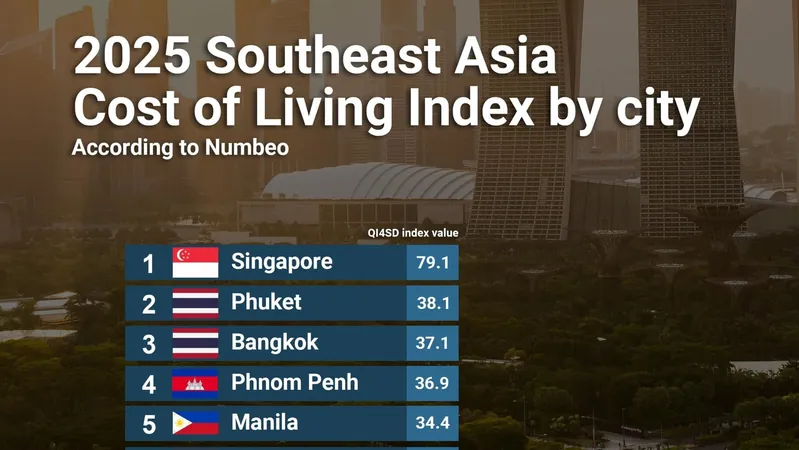
Singapore Tops Southeast Asia's Cost of Living Index - A Shocking Comparison with Neighboring Cities!
2025-01-08
Author: Siti
In a stunning revelation for those tracking economic trends in Southeast Asia, Singapore has secured the number one position in Numbeo’s Current Cost of Living Index, boasting a score of 71.1. This achievement marks a significant lead over Phuket, which rests in second place with a score of 38.1.
The remaining cities in the top 11 are as follows: Bangkok (37), Phnom Penh (36.9), Manila (34.4), Pattaya (33.2), Kuala Lumpur (33.1), Chiang Mai (29.5), Ho Chi Minh City (28.6), Jakarta (28.5), and Hanoi (27.8). The contrast in living costs is stark and evident, particularly when illustrated through visual graphics provided by Numbeo.
For the past decade, Singapore has consistently dominated the Cost of Living Index in Southeast Asia, highlighting a long-standing trend that underscores its status as a financial hub. The city-state’s scores reflect its high living expenses across various categories: rent (67.9), groceries (70.9), and restaurant prices (53.1). Remarkably, Singapore received an impressive score of 93.2 for local purchasing power, outpacing other cities, with only Kuala Lumpur achieving a better score at 109.2.
However, it is essential to consider that Numbeo's data originates from crowdsourced information concerning perceived consumer prices, property values, and quality of life metrics; hence, it might not always represent the complete picture.
According to Numbeo’s estimates, a family of four living in Singapore requires approximately $5,439.90 monthly to cover their expenses, excluding rent. In contrast, a single individual would require about $1,505.70. For those comparing with Phuket, the cost of living— rent included—is reported to be 59% lower than in Singapore, with rental costs nearly 70% cheaper and restaurant prices nearly halved. Interestingly, groceries in Singapore are reported to be over 36% pricier compared to Phuket.
Despite these lower costs, Phuket struggles with local purchasing power, which is nearly 60% less than that of Singapore. For perspective, an individual making $12,000 in Singapore would only need an income of $4,915 in Phuket to maintain a comparable standard of living.
As economic landscapes evolve rapidly, these findings raise critical questions: Will rising costs in Singapore prompt residents to explore opportunities elsewhere? How will neighboring countries adapt to this growing disparity? Stay tuned as we navigate the implications of these economic trends in Southeast Asia.
 Brasil (PT)
Brasil (PT)
 Canada (EN)
Canada (EN)
 Chile (ES)
Chile (ES)
 Česko (CS)
Česko (CS)
 대한민국 (KO)
대한민국 (KO)
 España (ES)
España (ES)
 France (FR)
France (FR)
 Hong Kong (EN)
Hong Kong (EN)
 Italia (IT)
Italia (IT)
 日本 (JA)
日本 (JA)
 Magyarország (HU)
Magyarország (HU)
 Norge (NO)
Norge (NO)
 Polska (PL)
Polska (PL)
 Schweiz (DE)
Schweiz (DE)
 Singapore (EN)
Singapore (EN)
 Sverige (SV)
Sverige (SV)
 Suomi (FI)
Suomi (FI)
 Türkiye (TR)
Türkiye (TR)
 الإمارات العربية المتحدة (AR)
الإمارات العربية المتحدة (AR)